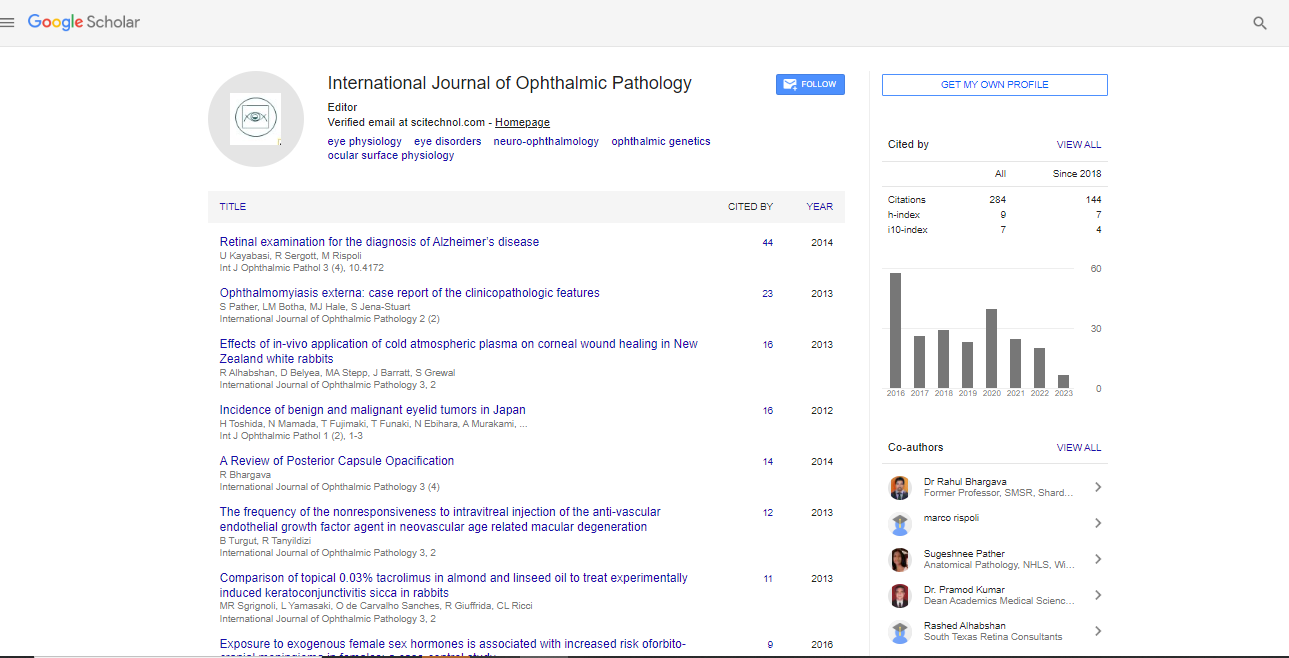Perspective, Vol: 14 Issue: 1
Restoring Eye Health with Dacryocystorhinostomy Fluid Discharge
Freitag Cuadrado*
Department of Ophthalmology, University of California San Diego, California, United States of America
*Corresponding Author: Freitag Cuadrado Department of Ophthalmology, University of California San Diego, California, United States of America, E-mail: freitcuadra@health.ucsd.edu
Received date: 07 April, 2024, Manuscript No. IOPJ-24-131715; Editor assigned date: 09 April, 2024, PreQC No. IOPJ-24-131715 (PQ); Reviewed date: 24 April, 2024, QC No. IOPJ-24-131715; Revised date: 07 February, 2025, Manuscript No. IOPJ-24-131715 (R); Published date: 17 February, 2025, DOI: 10.4172/2324-8599.1000060
Citation: Cuadrado F (2025) Restoring Eye Health with Dacryocystorhinostomy Fluid Discharge. Int J Ophthalmic Pathol 14:1.
Description
Dacryocystorhinostomy (DCR) is a surgical procedure performed to restore proper tears to form in cases of nasolacrimal duct obstruction. When the nasolacrimal duct is blocked, tears cannot drain normally, leading to symptoms such as excessive tearing, discharge and recurrent eye infections. DCR surgery aims to remove the impediment and develop a new evacuation transition for tears and restoring eye health. During a DCR procedure, the surgeon establishes a new connection between the lacrimal sac, where tears accumulate and the nasal cavity, allowing tears to drain directly into the nose. This bypasses the blocked portion of the nasolacrimal duct, relieving symptoms and preventing complications associated with tear stagnation. One of the primary symptoms of nasolacrimal duct obstruction is excessive tearing, known as epiphora. When the nasolacrimal duct is blocked, tears cannot drain properly, causing them to overflow onto the cheeks. This not only leads to discomfort and irritation but can also impair vision and cause social embarrassment.
DCR surgery helps alleviate epiphora by restoring normal tear drainage, allowing tears to flow freely from the eyes into the nasal cavity. In addition to excessive tearing, patients with nasolacrimal duct obstruction may experience recurrent eye infections and inflammation due to the stagnation of tears. When tears cannot drain properly, they accumulate in the lacrimal sac, establishing a favorable environment for bacterial growth. This can lead to conditions such as dacryocystitis, an infection of the lacrimal sac, which presents with symptoms such as pain, swelling and purulent discharge. By restoring tear drainage, DCR surgery helps prevent recurrent infections and inflammation, promoting overall eye health. Before undergoing DCR surgery, patients typically undergo a thorough evaluation to assess the severity and cause of nasolacrimal duct obstruction. This may involve a comprehensive eye examination, imaging studies such as dacryocystography or nasal endoscopy and functional tests to evaluate tear drainage.
Based on the findings, the surgeon can determine the most appropriate treatment approach, which may include DCR surgery. DCR surgery can be performed using various techniques, including external DCR and endoscopic DCR. In external DCR, the surgeon establishes a small incision on the skin close to the ocular's front corner, accesses the lacrimal sac, and establishes a new outflow into the nasal cavity. In endoscopic DCR, the procedure is performed using a nasal endoscope, which allows for a less invasive approach and shorter recovery time. During the DCR procedure, the surgeon may also place a stent or silicone tube to maintain the patency of the new outflow pathway while it heals. This helps prevent scar tissue formation and ensures proper tear drainage postoperatively. The stent is typically removed several weeks after surgery once the outflow pathway has fully healed. Following DCR surgery, patients may experience temporary symptoms such as mild discomfort, swelling and bruising around the surgical site. These usually resolve within a few days to weeks, and most patients can resume normal activities shortly after surgery.
Conclusion
However, it may take several weeks for the full benefits of DCR surgery to be realized, as the outflow pathway continues to heal and normalize. Overall, DCR surgery is highly effective in restoring tear outflow and relieving symptoms associated with nasolacrimal duct obstruction. Complications are rare but may include infection, bleeding, scarring or recurrence of symptoms. By restoring proper tear outflow, DCR surgery not only improves eye comfort and function but also helps prevent long-term complications and promotes overall eye health and well-being. Dacryocystorhinostomy (DCR) surgery is a highly effective procedure for restoring tear outflow and relieving symptoms associated with nasolacrimal duct obstruction. With advances in surgical techniques and instrumentation, DCR surgery has become a safe and reliable option for patients suffering from nasolacrimal duct obstruction, providing long-lasting relief and improved eye health.
 Spanish
Spanish  Chinese
Chinese  Russian
Russian  German
German  French
French  Japanese
Japanese  Portuguese
Portuguese  Hindi
Hindi 